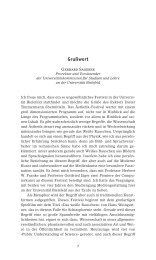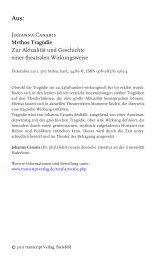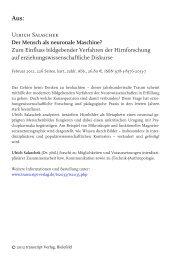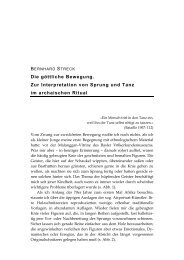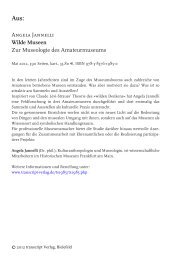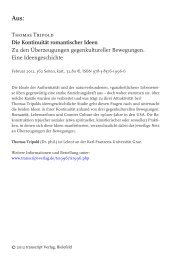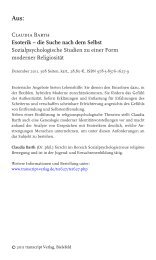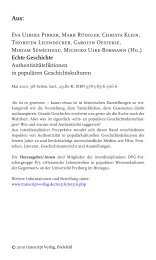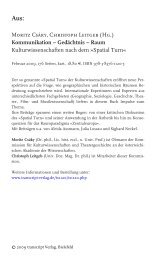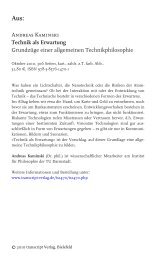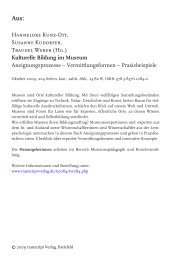Julia Straub (ed.) Paradoxes of Authenticity Studies on a Critical ...
Julia Straub (ed.) Paradoxes of Authenticity Studies on a Critical ...
Julia Straub (ed.) Paradoxes of Authenticity Studies on a Critical ...
Create successful ePaper yourself
Turn your PDF publications into a flip-book with our unique Google optimized e-Paper software.
Representing the Authentic<br />
INTRODUCTION | 21<br />
With J<strong>on</strong>athan Culler’s quotati<strong>on</strong> as a motto, the representability <str<strong>on</strong>g>of</str<strong>on</strong>g><br />
authentic experience as a pr<str<strong>on</strong>g>of</str<strong>on</strong>g>oundly ambivalent phenomen<strong>on</strong> has<br />
been emphasiz<str<strong>on</strong>g>ed</str<strong>on</strong>g>: representing authenticity means m<str<strong>on</strong>g>ed</str<strong>on</strong>g>iating what<br />
ought to be original since un-m<str<strong>on</strong>g>ed</str<strong>on</strong>g>iat<str<strong>on</strong>g>ed</str<strong>on</strong>g>. This affects certain m<str<strong>on</strong>g>ed</str<strong>on</strong>g>ia in<br />
particularly str<strong>on</strong>g ways, especially those which claim a high degree<br />
<str<strong>on</strong>g>of</str<strong>on</strong>g> referentiality for themselves, such as photography. At the latest<br />
with its digitizati<strong>on</strong>, photography has lost its indexical quality. Our<br />
awareness <str<strong>on</strong>g>of</str<strong>on</strong>g> its manipulability has increas<str<strong>on</strong>g>ed</str<strong>on</strong>g>. Drawing up<strong>on</strong> the field<br />
<str<strong>on</strong>g>of</str<strong>on</strong>g> rhetoric, Thomas Susanka approaches authenticity as something<br />
that is produc<str<strong>on</strong>g>ed</str<strong>on</strong>g> by semiotic means, focusing <strong>on</strong> c<strong>on</strong>temporary war<br />
photography from Iraq and Afghanistan. He argues that the veracity<br />
and authenticity <str<strong>on</strong>g>of</str<strong>on</strong>g> photographs, especially in a highly politiciz<str<strong>on</strong>g>ed</str<strong>on</strong>g> c<strong>on</strong>text<br />
as that <str<strong>on</strong>g>of</str<strong>on</strong>g> war journalism, can <strong>on</strong>ly be ascertain<str<strong>on</strong>g>ed</str<strong>on</strong>g> <strong>on</strong> a semiotic<br />
level, i.e. in awareness <str<strong>on</strong>g>of</str<strong>on</strong>g> the techniques employ<str<strong>on</strong>g>ed</str<strong>on</strong>g> by the photographer.<br />
According to Susanka, authenticity and photography enter into a<br />
relati<strong>on</strong>ship which is nowadays defin<str<strong>on</strong>g>ed</str<strong>on</strong>g> by the communicative strategies<br />
us<str<strong>on</strong>g>ed</str<strong>on</strong>g> by the photographer and the result <str<strong>on</strong>g>of</str<strong>on</strong>g> his subjective perspective.<br />
This also opens up debates <strong>on</strong> ethical journalism, i.e. the questi<strong>on</strong><br />
<str<strong>on</strong>g>of</str<strong>on</strong>g> what is ‘good’ versus ‘bad’ press photography. While the great majority<br />
<str<strong>on</strong>g>of</str<strong>on</strong>g> people living in the Western world lack first-hand experience<br />
<str<strong>on</strong>g>of</str<strong>on</strong>g> war, they have a very clear idea <str<strong>on</strong>g>of</str<strong>on</strong>g> what it should look like. This<br />
‘look <str<strong>on</strong>g>of</str<strong>on</strong>g> war’ is creat<str<strong>on</strong>g>ed</str<strong>on</strong>g> by photographers who transgress traditi<strong>on</strong>al<br />
aesthetic norms <str<strong>on</strong>g>of</str<strong>on</strong>g> photography by minimizing the effects <str<strong>on</strong>g>of</str<strong>on</strong>g> intenti<strong>on</strong>ality<br />
and prem<str<strong>on</strong>g>ed</str<strong>on</strong>g>itati<strong>on</strong>.<br />
The essays by Irmtraud Huber and Christa Schönfelder are c<strong>on</strong>cern<str<strong>on</strong>g>ed</str<strong>on</strong>g><br />
with the truthfulness <str<strong>on</strong>g>of</str<strong>on</strong>g> narratives and the representati<strong>on</strong> <str<strong>on</strong>g>of</str<strong>on</strong>g><br />
traumatic experience. Ethical demands plac<str<strong>on</strong>g>ed</str<strong>on</strong>g> <strong>on</strong> literature and narrative<br />
explorati<strong>on</strong>s <str<strong>on</strong>g>of</str<strong>on</strong>g> the past and the questi<strong>on</strong> <str<strong>on</strong>g>of</str<strong>on</strong>g> how authentic the self<br />
and narratives can and or even must be – these aspects come together<br />
in these two essays. The novels which Huber and Schönfelder each<br />
discuss deal with traumatic experiences and their effects <strong>on</strong> human beings<br />
and their identities. The works <str<strong>on</strong>g>of</str<strong>on</strong>g> Saul Fri<str<strong>on</strong>g>ed</str<strong>on</strong>g>länder and Theodor<br />
W. Adorno have attun<str<strong>on</strong>g>ed</str<strong>on</strong>g> readers to the ethical charge inherent in writing<br />
about atrocities endur<str<strong>on</strong>g>ed</str<strong>on</strong>g> by <strong>on</strong>eself or others and the difficulty <str<strong>on</strong>g>of</str<strong>on</strong>g><br />
finding the right words and the right form to c<strong>on</strong>vey such experience.



